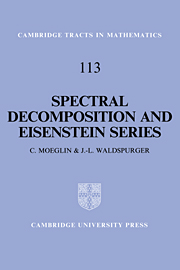Crossref Citations
This Book has been
cited by the following publications. This list is generated based on data provided by Crossref.
Kim, Henry H.
1996.
The Residual Spectrum ofG2.
Canadian Journal of Mathematics,
Vol. 48,
Issue. 6,
p.
1245.
Zhang, Yuanli
1997.
The holomorphy and nonvanishing of normalized local intertwining operators.
Pacific Journal of Mathematics,
Vol. 180,
Issue. 2,
p.
385.
Kapranov, M. M.
1997.
Eisenstein series and quantum affine algebras.
Journal of Mathematical Sciences,
Vol. 84,
Issue. 5,
p.
1311.
Tan, Victor
1998.
A regularized Siegel-Weil formula on U(2,2)
and U(3).
Duke Mathematical Journal,
Vol. 94,
Issue. 2,
Ji, Lizhen
1998.
The trace class conjecture for arithmetic groups.
Journal of Differential Geometry,
Vol. 48,
Issue. 1,
Ji, Lizhen
1999.
The Weyl upper bound on the discrete spectrum of locally symmetric spaces.
Journal of Differential Geometry,
Vol. 51,
Issue. 1,
Gelbart, Stephen
and
Shahidi, Freydoon
2000.
Boundedness of automorphic 𝐿–functions in vertical strips.
Journal of the American Mathematical Society,
Vol. 14,
Issue. 1,
p.
79.
Kim, Henry H.
and
Shahidi, Freydoon
2000.
Holomorphy of Rankin tripleL-functions; special values and root numbers for symmetric cubeL-functions.
Israel Journal of Mathematics,
Vol. 120,
Issue. 2,
p.
449.
Kim, Henry H.
2000.
Langlands-shahidi method and poles of automorphicL-functions II.
Israel Journal of Mathematics,
Vol. 117,
Issue. 1,
p.
261.
Muić, Goran
and
Savin, Gordan
2000.
Complementary Series for Hermitian Quaternionic Groups.
Canadian Mathematical Bulletin,
Vol. 43,
Issue. 1,
p.
90.
Ginzburg, David
Jiang, Dihua
and
Rallis, Stephen
2001.
Nonvanishing of the central critical value of the third symmetric power L-functions.
Forum Mathematicum,
Vol. 13,
Issue. 1,
Jantzen, Chris
and
Kim, Henry H.
2001.
Parametrization of the image of normalized intertwining operators.
Pacific Journal of Mathematics,
Vol. 199,
Issue. 2,
p.
367.
Miller, S. D.
2001.
On the existence and temperedness of cusp forms for SL3(Z).
Journal für die reine und angewandte Mathematik (Crelles Journal),
Vol. 2001,
Issue. 533,
Ginzburg, David
and
Jiang, Dihua
2001.
Periods and liftings: FromG 2 toC 3.
Israel Journal of Mathematics,
Vol. 123,
Issue. 1,
p.
29.
Kim, Henry H.
2001.
Residual spectrum of split classical groups; contribution from Borel subgroups.
Pacific Journal of Mathematics,
Vol. 199,
Issue. 2,
p.
417.
Kim, Henry
2002.
Functoriality for the exterior square of 𝐺𝐿₄ and the symmetric fourth of 𝐺𝐿₂.
Journal of the American Mathematical Society,
Vol. 16,
Issue. 1,
p.
139.
Watanabe, Takao
2003.
The Hardy-Littlewood property of flag varieties.
Nagoya Mathematical Journal,
Vol. 170,
Issue. ,
p.
185.
Gelbart, Stephen
and
Miller, Stephen
2003.
Riemann’s zeta function and beyond.
Bulletin of the American Mathematical Society,
Vol. 41,
Issue. 1,
p.
59.
Beineke, Jennifer
and
Bump, Daniel
2003.
Renormalized Periods on GL(3).
Canadian Journal of Mathematics,
Vol. 55,
Issue. 5,
p.
933.
Lapid, Erez M.
and
Rogawski, Jonathan D.
2003.
Periods of Eisenstein series: The Galois case.
Duke Mathematical Journal,
Vol. 120,
Issue. 1,





